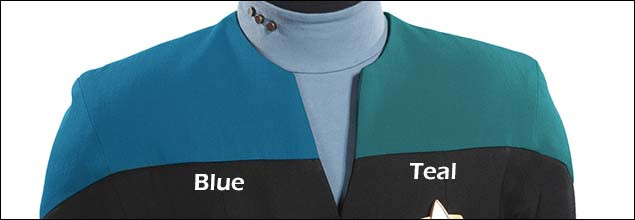The uniforms in Star Trek: Voyager are more than just clothing; they are a visual language that instantly communicates a crew member’s primary role aboard the starship. Throughout the series, the crew sports the Standard Duty Uniform (SDU) style, a design first seen in 2369, a couple of years before the USS Voyager embarked on its ill-fated journey to the Delta Quadrant. These Star Trek Voyager uniforms, while seemingly simple, hold a depth of meaning for fans and are a key element of the show’s visual identity.
As with the uniforms of Star Trek: The Next Generation era, the Voyager uniform utilizes a system of three distinct division colors to denote the wearer’s primary area of expertise:
- Red: This bold color signifies Command and Operations. Individuals in command positions, such as Captain Kathryn Janeway, as well as those in operational roles like helmsman Tom Paris, wear red uniforms.
- Gold: Gold denotes Operations, specifically for Engineering, Security, and Communications personnel. Officers in these critical departments are identified by their gold-colored uniforms.
- Blue: Blue is the color for Sciences and Medical. Science officers, doctors, and research personnel on Voyager wear blue, indicating their primary focus on scientific exploration and healthcare.
 Star Trek Voyager uniform color divisions: command red, operations gold, and sciences blue
Star Trek Voyager uniform color divisions: command red, operations gold, and sciences blue
It’s important to note that while the SDU style was officially retired by Starfleet in 2371, the Voyager crew continued to wear it for the entirety of the series. This was a direct consequence of their being stranded light-years away from Starfleet support in the Delta Quadrant, highlighting their resourcefulness and resilience. The SDU design inverted the color scheme of the earlier two-piece TNG uniforms, featuring a predominantly black uniform with division color accents on the shoulders and collar. This design choice further minimized the color compared to the subsequent Dominion War-era jumpsuit style, which debuted in Star Trek: First Contact and became prominent in later seasons of DS9.
Beyond Primary Roles: Dual Expertise in Voyager’s Crew
The color of a Star Trek Voyager uniform primarily indicates an officer’s assigned division, reflecting their core responsibilities. However, it doesn’t always encompass the full spectrum of their skills and expertise. In Starfleet, and especially aboard a ship like Voyager operating far from support, versatility is crucial. Officers often possess skills that extend beyond their primary role.
For instance, while Tom Paris wears red as Voyager’s helmsman (Operations), he is also deeply knowledgeable in aerodynamics and warp field theory, areas typically associated with the Sciences division. Similarly, Captain Kathryn Janeway, in her command red uniform, is fundamentally a scientist and physicist. Her background as a Science Officer before becoming Executive Officer of the USS Billings underscores that her command role is built upon a strong foundation of scientific expertise. In the unique circumstances of Voyager, limited crew necessitated that individuals “wear multiple hats,” drawing upon diverse skill sets to ensure the ship’s survival and mission success.
Historical Uniform Variations and Color Perceptions
It’s fascinating to remember that uniform colors weren’t always consistent across Star Trek series. In Star Trek: The Original Series, the colors for Command and Operations were actually reversed. Furthermore, The Original Series featured a Captain’s tunic variant in a distinctive light green (avocado) hue with gold sleeve piping, adding another layer of variation to Starfleet uniforms.
 Captain Kirk's green tunic variant from Star Trek: The Original Series, a predecessor to the Star Trek Voyager uniform
Captain Kirk's green tunic variant from Star Trek: The Original Series, a predecessor to the Star Trek Voyager uniform
Additionally, alternate timelines and realities within Star Trek lore sometimes depict characters wearing uniform colors different from their usual assignments. Episodes like “Parallels” in TNG and “Tapestry” also in TNG showcase characters in unexpected uniform colors, highlighting the fluidity of identity and roles across different realities. Even Voyager’s Doctor, when activating his Emergency Command Hologram (ECH), temporarily shifts from his blue Sciences uniform to a red Command uniform, demonstrating a change in function denoted by uniform color.
The Blue vs. Teal Uniform Color Debate
Finally, when discussing Star Trek Voyager uniforms, a recurring point of discussion among fans is the apparent inconsistency in the shade of blue used for the Sciences division. While officially designated as a deep sapphire blue, the science uniforms sometimes appear as more of a teal color on screen. This variation is likely due to subtle differences in fabric dyes and lighting conditions during filming. As illustrated in the comparison image, the two shades can appear quite distinct, and under certain lighting, the teal version might even be perceived as green, especially by individuals with blue-yellow colorblindness (tritanopia).
 Side-by-side comparison of deep sapphire blue and teal science Star Trek uniforms, highlighting color variations in Voyager
Side-by-side comparison of deep sapphire blue and teal science Star Trek uniforms, highlighting color variations in Voyager
In conclusion, the Star Trek Voyager uniform is a rich visual element of the series, communicating division assignments through color while also hinting at the diverse skills and evolving roles of the crew. Understanding the nuances of these uniform colors enhances appreciation for the detailed world-building and character development within Star Trek: Voyager.
